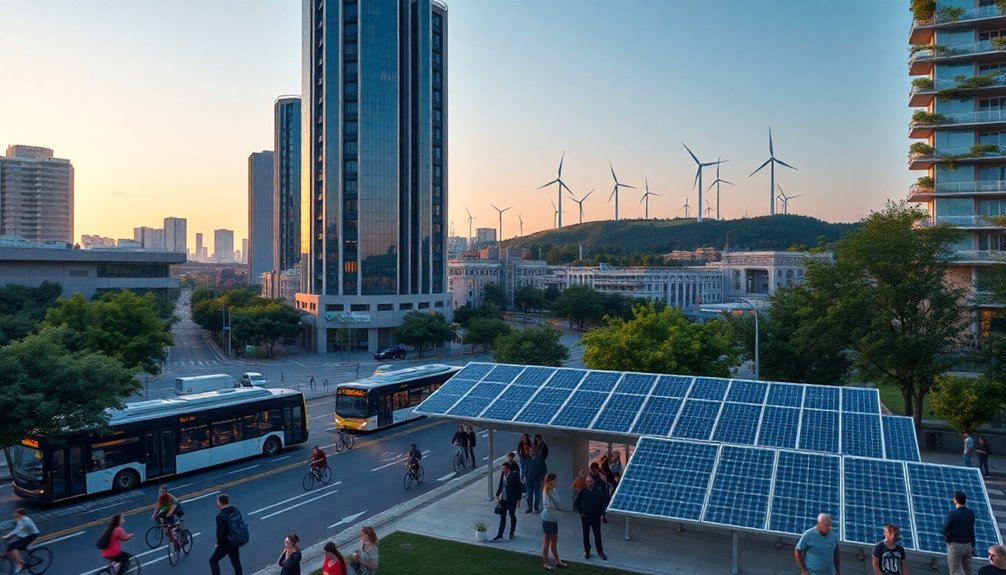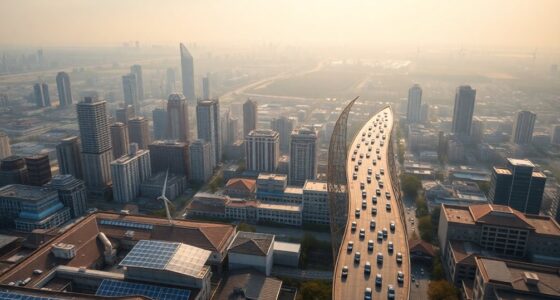Urban decarbonization is crucial for creating sustainable cities and tackling climate change. To reduce emissions, focus on enhancing energy efficiency, electrifying transportation, and improving waste management. Embrace innovative urban planning that incorporates green spaces and mixed-use developments. Policies that promote building retrofits can significantly lower carbon footprints. By adopting these sector-specific strategies, you'll see how they collectively contribute to a cleaner, healthier urban environment. Explore how these measures can transform your city further.
Key Takeaways
- Urban decarbonization necessitates enhanced energy efficiency and renewable energy integration to reduce emissions and reliance on fossil fuels.
- Transportation electrification through electric vehicles and improved public transport systems significantly lowers urban emissions and promotes sustainable mobility.
- Effective waste management strategies, including recycling and composting, play a crucial role in minimizing landfill waste and harmful methane emissions.
- Strategic urban planning, featuring green spaces and mixed-use developments, fosters sustainable lifestyles and reduces overall carbon footprints.
- Robust policy frameworks and building retrofits incentivize energy efficiency, transitioning away from gas dependence and promoting sustainable urban practices.

As cities continue to grow, the urgent need for urban decarbonization measures becomes increasingly clear. You can play a vital role in this transformation by embracing key principles that enhance energy efficiency and integrate renewable energy. Improving energy efficiency in buildings and infrastructure not only reduces energy consumption but also cuts emissions significantly.
By integrating renewable sources like solar and wind, you can help lessen reliance on fossil fuels, paving the way for a cleaner urban environment. The increasing share of renewable energy in global energy consumption underscores the importance of this transition.
Transportation electrification is another crucial area where you can make an impact. Shifting to electric vehicles and enhancing public transport systems dramatically reduces emissions from urban mobility. When cities invest in walking and cycling infrastructure, they promote healthier lifestyles while cutting down on fossil fuel use.
Transportation electrification is vital for reducing urban emissions, promoting electric vehicles, and enhancing public transport for a sustainable future.
Encouraging telecommuting can also reduce the need for daily commutes, lowering emissions further.
Effective waste management strategies are essential in this decarbonization journey. By boosting recycling efforts and implementing community composting programs, you can minimize waste sent to landfills and decrease harmful methane emissions.
Waste-to-energy technologies can convert waste into a low-carbon energy source, showcasing the potential of innovative solutions.
Urban planning plays a pivotal role in achieving sustainability. Designing cities with ample green spaces and efficient layouts not only enhances livability but also reduces carbon footprints.
Mixed-use developments encourage walkability and minimize travel needs, making it easier for you to adopt a more sustainable lifestyle.
Finally, implementing robust policy frameworks that incentivize decarbonization in buildings can accelerate widespread adoption. By retrofitting existing structures with energy-efficient materials and systems, you contribute to a significant reduction in emissions.
Transitioning to electric heating further complements this effort, moving away from gas dependence.
Frequently Asked Questions
What Are the Main Barriers to Urban Decarbonization?
You'll find that the main barriers to urban decarbonization include a lack of political will, regulatory challenges, and limited public engagement.
Financial constraints also play a big role, making it tough for cities to invest in sustainable initiatives.
Additionally, outdated infrastructure and technology adoption costs hinder progress.
Social inequalities can further complicate access to benefits, while operational hurdles arise from integrating decarbonization into existing urban planning frameworks.
How Can Residents Contribute to Decarbonization Efforts?
Imagine walking through a green neighborhood, where the air feels fresher and the streets buzz with electric cars.
You can help create this reality! By adopting renewable energy like solar panels, using energy-efficient appliances, and supporting local initiatives for sustainable transport, you'll actively contribute to decarbonization.
Engage in community forums and advocate for policies that align with your needs, ensuring a cleaner, healthier environment for everyone.
Your participation matters!
What Technologies Are Emerging for Urban Decarbonization?
You'll find several emerging technologies pivotal for urban decarbonization.
Innovative building materials with lower carbon footprints are gaining traction, alongside carbon capture systems that remove CO2 from the atmosphere.
Energy storage advancements are supporting renewable energy integration, while smart city technologies optimize energy management and efficiency.
Plus, nature-based materials enhance sustainability, creating greener urban spaces.
These innovations collectively contribute to reducing emissions and promoting a cleaner, healthier environment for everyone.
How Do Decarbonization Measures Impact Local Economies?
Decarbonization measures significantly impact local economies by creating jobs and boosting investment.
When you invest in renewable energy and energy-efficient projects, you're not just reducing emissions; you're also generating construction and clean manufacturing jobs.
These efforts can lower energy costs for residents, enhancing economic stability.
Plus, as communities transition to cleaner energy, you'll likely see improved public health and resilience, creating a more vibrant local economy for everyone involved.
What Role Do Policy Makers Play in Urban Decarbonization?
You play a crucial role in urban decarbonization by crafting policies that drive change.
By implementing regulatory mandates, you ensure buildings reduce emissions and become more efficient. Your financial incentives make compliance easier for businesses, while public-private partnerships help mobilize resources effectively.
Engaging with the community allows you to gather feedback and build support for these initiatives, ensuring that decarbonization efforts are equitable and sustainable for all residents in your city.
Conclusion
In conclusion, embracing urban decarbonization measures means committing to cleaner air, sustainable energy, and thriving communities. By prioritizing green transportation, enhancing energy efficiency, and investing in renewable resources, you're not just reducing emissions; you're fostering resilience and innovation. Each step you take toward decarbonization leads to healthier environments, vibrant economies, and a brighter future for all. Together, let's build cities that not only exist but thrive in harmony with our planet.








